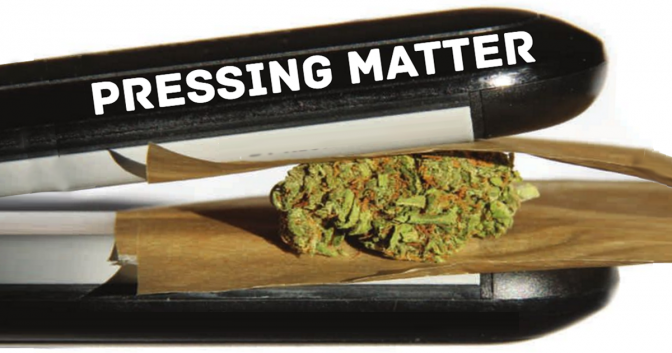Rosin: The Hot Concentrate

Rosin traditionally refers to the heated and solidified resin that comes from pine trees, which is used for many industrial purposes. But in cannabis circles, “rosin” is the term for oil that’s made from either flowers or cold-water hash (CWH) using a distinct, often home-made, process.
Hair irons were originally employed— and sometimes still are—to press the cannabis into rosin. Place a few grams of flower or hash in a silkscreen bag and then onto a sheet of parchment paper. Press it and a slab of rosin is produced.
Although many cannabis users have still never seen or tried it, rosin hit the market like a typhoon a couple of years ago. In these days of social media, the secrets of making good rosin soon spread far and wide from its origins in Northern California, and enthusiasm for rosin continues to grow. The primary reason is that it’s so easy to make.
At first, the only things needed were bud, parchment paper and a $50 curling iron, which certainly contributed to the rapid rise of this type of cannabis concentrate. Made without using the toxic and volatile solvent butane—with its ever-present risk of explosion—the production of high-quality, dabbable rosin extracts is simple and safe.
Rosin has become an alternative to BHO (butane honey oil) and CO2 products. Professionals now employ a bench press that uses both heat and pressure to extract the THC-rich oil from the source material. The presses used by Tim Blake and the folks at Healing Harvest Farms, in Mendocino, cost a few thousand dollars. The units are about five feet tall and consist of a bench with a press plate above it that heats up.
The crew at Healing Harvest uses CWH as a source material, which they manufacture from small buds and leaf. The super-dry hash is placed into small silkscreen bags in roughly three-gram loads. The bags are then folded into parchment paper. The plate, which is hydraulically driven, presses down onto the folded parchment. The exact amount of time and pressure used are trade secrets, but in short order the paper is removed from the press and the unveiling commences.
High-quality CWH produces rosin that’s almost white and is filled with deep, rich terpene aromas. Lower-quality hash yields rosins that are darker in color and less aromatic. OG rosin displays the classic lemon-pine smell of its source material, while Jack Herer just screams pine forest. Beyond its aesthetic appeal, rosin is a boon to dabbers; unlike CWH, high-quality rosin melts more like BHO wax or shatter. For a generation of dabbers raised on products that fully melt, rosin is the perfect fit.
But rosin is not without its challenges. The yields from both fresh buds and CWH are relatively low (especially if you factor in how low the yield of CWH is to begin with). When rosin first hit the market in 2014, its price of $30–$50 a gram wholesale, and double that retail, justified making it. As with every new concentrate trend, when more people started producing rosin, the price inevitably dropped. Rosin is currently wholesaling for $20–$30 a gram, making its continued viability questionable. For the moment, at least, hobbyist home growers will continue to produce high-grade rosin for their own personal enjoyment.
As a connoisseur product, rosin is one the purest forms of concentrated cannabis. No solvents or gases are needed—just heat and pressure. The resulting terpene-rich oil bursts with tantalizing aromas and is filled with flavor. The fact that anyone with some fresh buds or CWH can make it with a curling iron allows people to produce their own high-quality concentrates at home without the risk of BHO blowing themselves or others to bits.
Nearly every year for the last decade some new concentrate has emerged. CWH (via bubble bags) was followed by BHO wax and shatter. When butane explosions became commonplace and states such as California banned the production of it, many people switched to CO2 to extract concentrates. Today, rosin, with its low barrier to entry, has become hugely popular. The future will surely bring more adaptations and new production methods, perhaps including cold pressing. Cannabis aficionados are some of the most creative innovators on Earth, so whatever the next trend is, it’s bound to be interesting.
If you enjoyed this Freedom Leaf article, subscribe to the magazine today!

